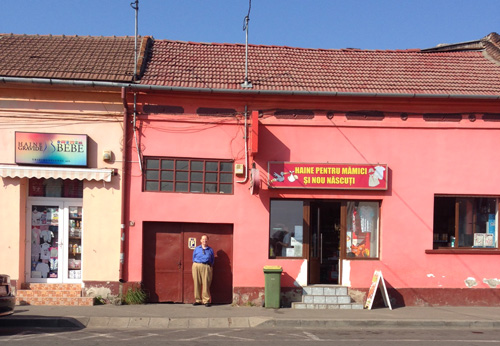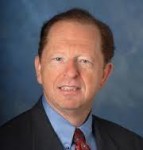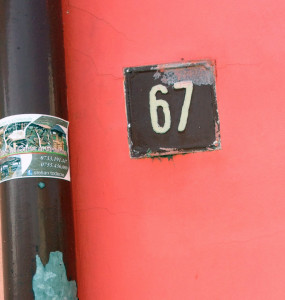
By Howard Wayne


SAN DIEGO — My maternal grandmother immigrated to the United States from the Kingdom of Hungary in the Austro-Hungarian Empire, in around 1910. She visited her family twice between the world wars, and afterwards sent some money to her father, Joseph Weinstein (or Weinstein Jozcef in Hungarian). As far as we knew, the family was wiped out during the Holocaust.
After my grandmother died I found a jewelry box among her effects that contained some of the postal receipts she has sent to Europe. The address address on the receipts for her father was 67 Kolozcvory, u in Orodei Mare (now Oradea), Romania. My mother told me the area was transfered to Romania after World War I, and my grandmother had to be careful to refer to the area as Romania, not Hungary. The region was under Soviet occupation when my grandmother died, and I just put the box away as a family heirloom.
Last year my wife Mary and I decided to take a Danube cruise from Romania to Budapest. I learned that Oradea was a five hour train trip from Budapest, so I planned to see if at the end of the tour I could find my great grandfather’s place. Shortly after arriving in Budapest in June of this year, we fought our way through the language barrier (Hungarian is nearly impossible for westerners) and bought round-trip tickets.
We arrived in Oradea shortly before midnight on a Wednesday. The train station was dark, but we found a cab to take us to our hotel. We had intentionally booked a Hilton hotel on the belief the staff would be able to communicate with us and get us an English-language guide. All I would have to do then would be show the guide the address, get a ride to the location, take some photos and, Mission Accomplished! Then we would check-out the city of Cluj.
Our first setback was when we arrived and the hotel staff said their English-language guide was on vacation and out of the country for the week. But they promised to see what they could do. And they corrected my pronunciation – it’s “Or RA Dea,” with the accent on the second syllable. The next morning we looked out our window and saw the Crisul Repede River, from which the region derives its name, Crisana. The hotel staff said they would keep looking for a guide and suggested we just take a walk into town. It was a hot day. We crossed the main thoroughfare, wandered around and sat at a table in a park. Mary bought a cold drink and I purchased a detailed street map. I looked for Kolozcvory Street – no such place was listed. The street name sounded Hungarian and most likely the Romanians had changed its names. But to what?
I noticed there was a synagogue just across the river. So my thought was to go there and perhaps someone in the Jewish community would be able to tell me the new name of the street – or maybe (hope against hope) knew something about the family. So we went across the river, found the street badly torn up as part of a road repair, and looked for the synagogue. We saw it – behind chain link fence. It was being rebuilt and re-purposed, with European Union money, as a museum. Perhaps this was symbolic of the Jewish community in Oradea.
We went back to the hotel room to cool down. I looked at my map and saw there was an Orthodox synagogue not terribly far from where we had been. Leaving Mary behind, I hiked to the vicinity of that synagogue. It was a magnificent building – and also behind a chain link fence. Bushes grew around the gate entrance – it had not been opened in some time. Perhaps, having come this far chasing my great grandfather’s ghost, I wasn’t going to find it.
As I cut through a parking lot I looked back and saw a Star of David flag. “Maybe there is something here,” I thought. So I turned back and found an open gate – and a guard. He was taciturn, didn’t speak English, and tried to chase me away. I didn’t notice he had a gun. I walked by the chain link fence and found a banner advertising a Kosher restaurant. I located the place on my map and walked over. Over a cold drink I talked to the waiter, Adam, who spoke English. He told me the Star of David flag was at the Jewish Community Center and encouraged me to go back the next day.
After having dinner with Mary I went to the hotel’s business office and got on the computer. I ran a Google search of Kolozcvory and Oradea. Nothing definite showed up, but I found a clue. A post said the Murantha Adventist Church was located at Kolozvani ut 32, with Kolozcvory in parenthesis, and with a mention of a street, Calea Clujulvi. On my map Calea Clujulvi appeared as a major street, and not far across the river from where we were staying.
Friday morning the hotel staff told us that the guide they thought they could get us was ill, but that they would continue to look. Mary and I went to the Orthodox synagogue and the same angry guard was on duty. Luckily a driver who spoke some English was leaving the facility. He invited us to come back at 8:30 for services and, by the way, to bring our passports. We went to the Kosher restaurant and Adam pointed us to the Town Hall near the river. We decided to walk over there.
The Town Hall is a magnificent structure, built in what I am told is the Secessionist style. At the Planning Department we found a clerk who spoke some English. She told us there was never a street called Kolozcvory; that the word was in fact the former Hungarian name of Oradea. That made no sense to me. For one thing, on the postal remit Kolozcvory was preceded by the number “67,” which indicates a street address. It was followed by the letter “u,” which is a Hungarian abbreviation for “street.” Second, the former Hungarian name for Oradea is Nagyvarad. Finally, if it was not a street address, how would the money have gotten to my great grandfather?
On a hunch we went to the Vital Statistics department and were assisted by a very helpful clerk who also spoke English. Although he could not provide the information I was seeking, he told me on the sly that he’s Hungarian too. Perhaps I was a victim of the first clerk’s anti-Hungarian prejudice!
Mary and I returned to the synagogue that night. The same guard was there and I saw he was carrying a gun. We were greeted by Koppelmann Teodor-Felix, the president of the Jewish Community in Oradea. I introduced myself, showed him a copy of the postal receipt, explained what I was trying to do and showed him my passport. The guard checked it warily – he had developed a real dislike for me. With my papers in good order, Koppelmann had the guard take us into the old synagogue that was being rebuilt. Inside there were beautiful stained glass windows and the beginnings of the laying of a mosaic floor. Koppelmann said it would be restored within a year.
Kippelmann introduced us to a 16-year old girl, Miriam, who was studying English, and told her to take care of us. I asked Miriam when services would start and she said they were waiting for a minyan. I inquired if I could count towards it. We were escorted to the Shul, which was being temporarily used until the synagogue was rebuilt. I was warmly received by the rabbi, who spoke English, and by others to whom I was introduced. I went into the prayer hall; it was small with a rough-hewn wooden floor and wooden benches. It could have been a set for Fiddler on the Roof.
Mary sat on a bench on the other side of the room from me with the female congregants. After about twenty to twenty-five minutes of prayers the rabbi began his sermon in English, with an aid translating it into Romanian. The rabbi noted the presence of visitors from the United States, including one (me) with a family connection to Oradea. He spoke movingly about people who remember their past. There were also two American women from New Jersey in the Shul, both with spousal connections to the area. Services continued until 9:30. We moved back to the entry hall, had a glass of wine and wished each other shalom.
Miriam introduced me a gentleman, George, who knew the history of Oradea, and she offered to translate. He knew immediately that Kolozcvory is now called Calea Clujului, and that it had been in a Jewish part of town before World War II. He knew nothing of the Weinstein family, and said that under fear of persecution the congregations in town had burned family records when Oradea went back to Hungary (that was in 1940, as part of Hitler’s Vienna Awards). George said the area around the Orthodox Synagogue had been turned into a ghetto during the war. The Jewish population of Oradea, about 25% before the war, is now 600-700 families.
The next day the hotel got us an English-language guide, who also recognized the new name of Kolozcvory as Calea Clujului. That became the first stop on our tour. What we found at 67 Kolozcvory was a blank wall with a locked door, and a mini-mart. The number “67” was written on the wall next to a drain pipe. No real door to knock on or people to meet. I made a purchase at the mini-mart that might have been my great grandfather’s store and we took our photos. It wasn’t all I would have liked, but it was mission accomplished.
About a month later, back in San Diego, I looked at a map in a book on Hungarian history I’d bought in Budapest. The post-Treaty of Trianon (1919) map showed Oradea under its Hungarian name, Nagyvarad, and to the east and south another city with the Hungarian name Kolozsvar. My great grandfather’s street seems to have been an adjective version of this Hungarian name for this city, which is now called Cluj.
*
Wayne represented San Diego for the maximum three terms in the California State Assembly.